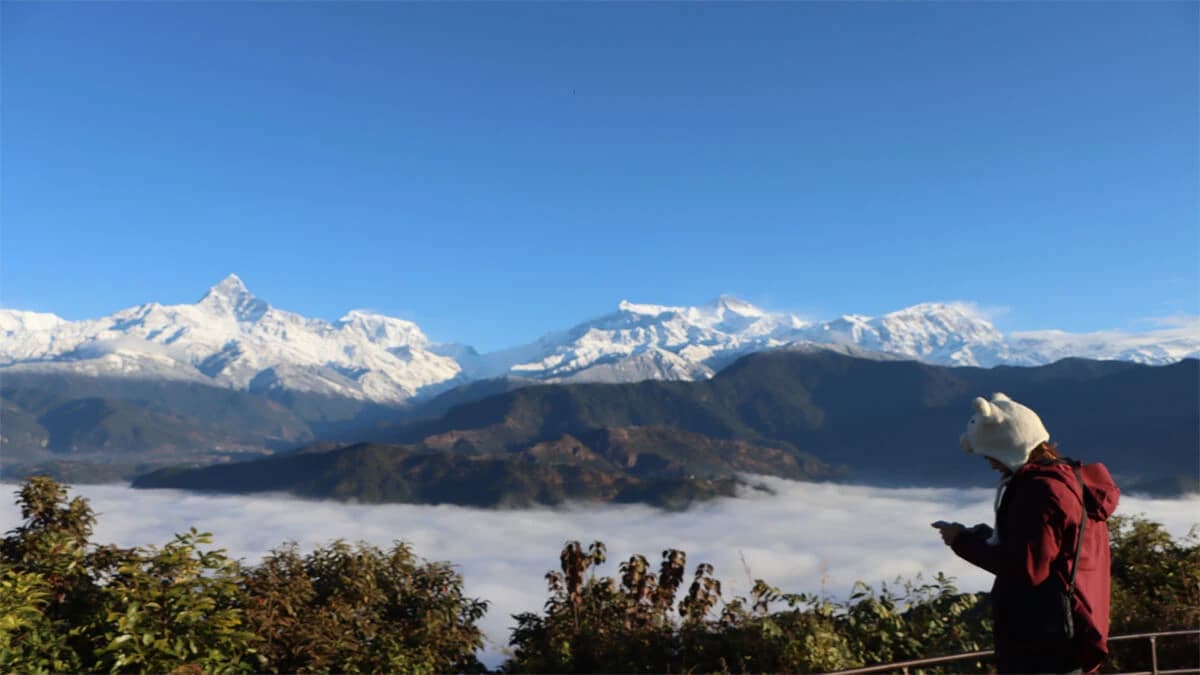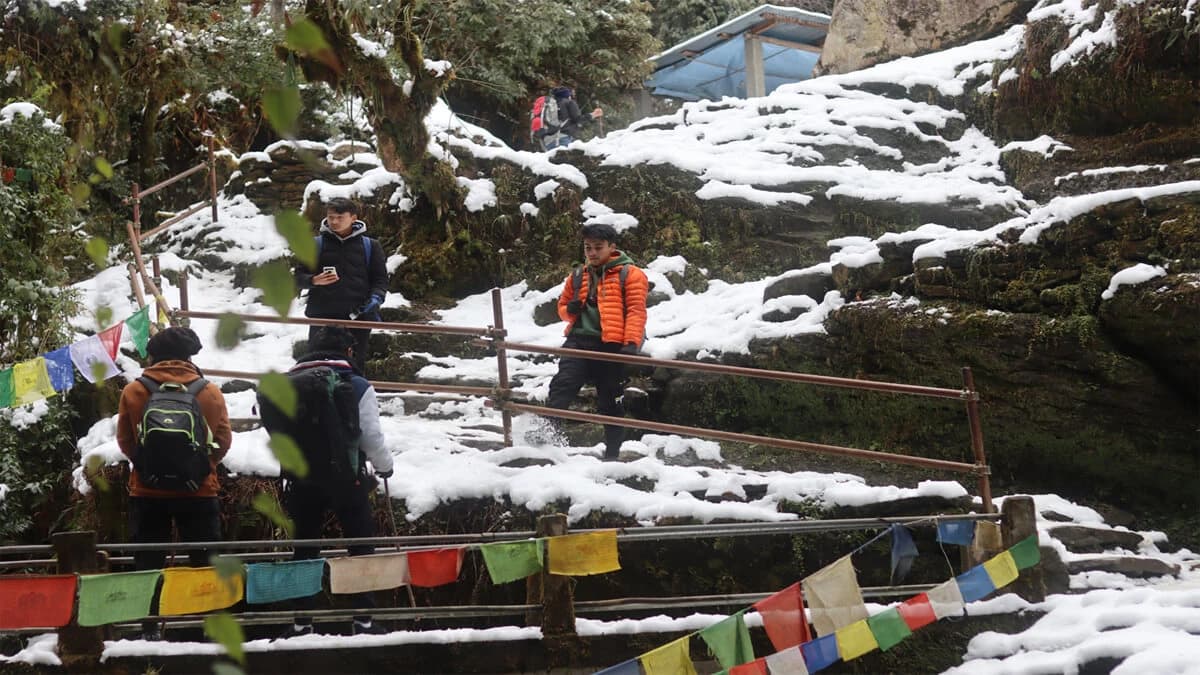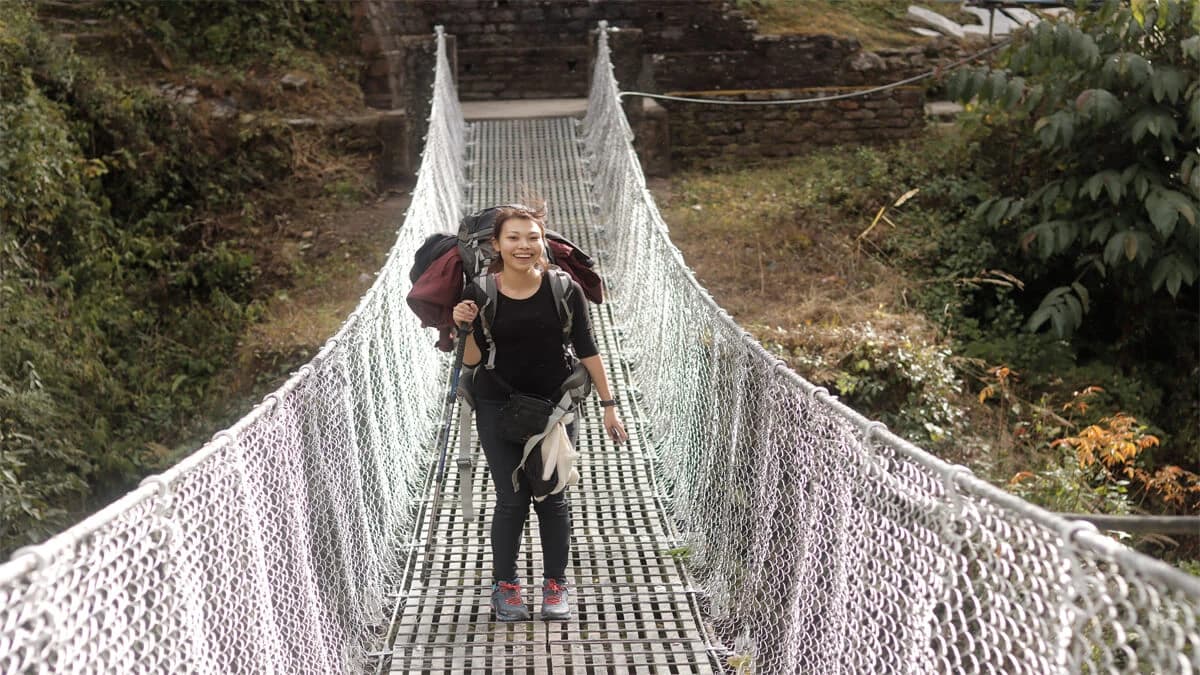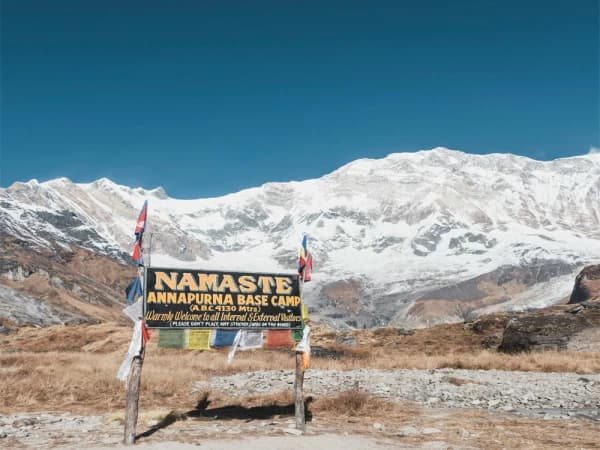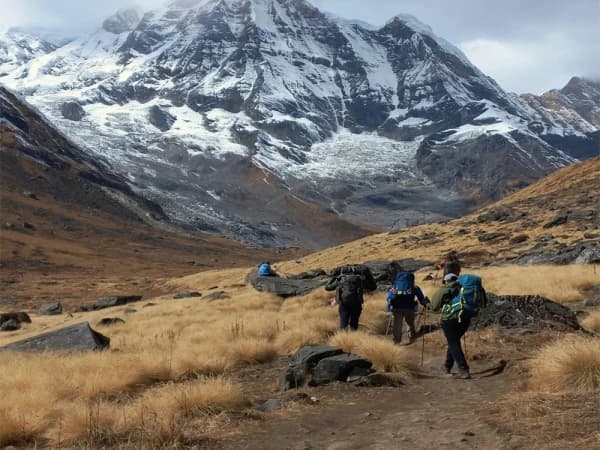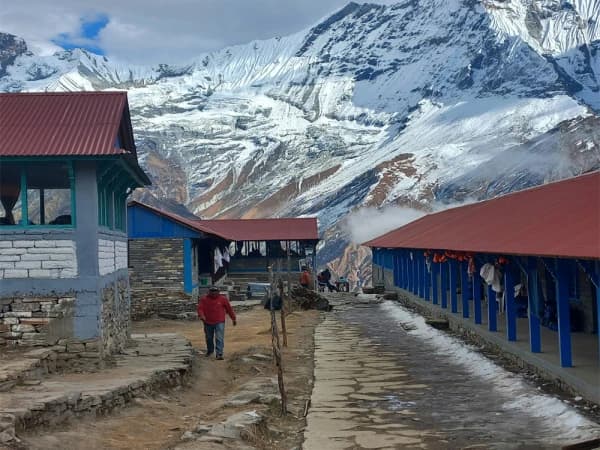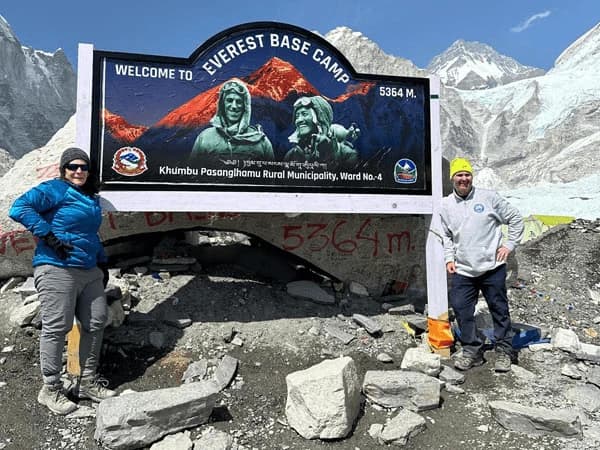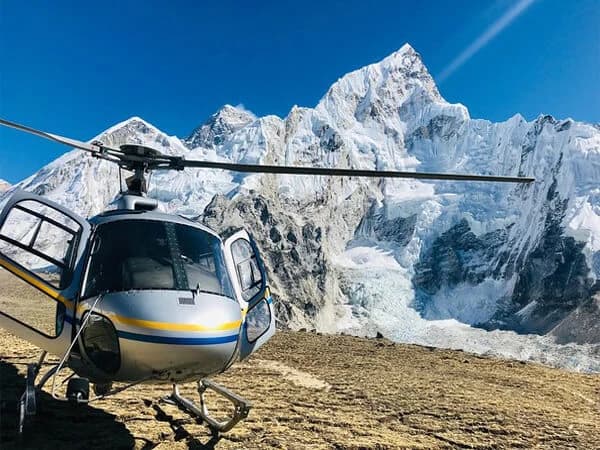Annapurna Base Camp Trekking Overview
Annapurna base camp trek is ranks first position among the best treks in Nepal. Located in the Gandaki Province, it is the major highlight of the Annapurna Region Trek. The well-maintained trails are more comfortable than the other trekking routes in Nepal. Thus, almost one-third of Nepal's trekkers do Annapurna Sanctuary Trek.
Experience Nepal Annapurna Trek which is officially beginning from Nayapul, moves through deep forests and ethnic villages. The rhododendron, oak, pine, fir, and birch trees of the Annapurna Conservation Area Project (ACAP) shelter various birds and animals. Ghorepani Poon Hill trek takes you through the largest rhododendron forests in the world. Also known as Annapurna Sunrise View Trek, also call Ghorepani Poon Hill Trek serves the best sunrise view of the towering Himalayas in the world.
From the elevation of 3,210 m, the dazzling view of the Annapurna (8,091 m), the Dhaulagiri (8,167 m), Annapurna South (7,219 m), and Mt. Fishtail (6,993 m) is just amazing! Other Himalayas seen during the 15-day Annapurna Base Camp Trek are Mardi Himal (5,587 m), Annapurna II (7,937 m), Gangapurna (7,455 m), Singu Chuli (6,501 m), Kangsar Kang (7,454 m), Hiunchuli (6,441 m). In a single trip, you will reach the base camps of two mountains: Annapurna I (8,091 m) and Machhapuchhre (6,993 m). Both the base camps are recognized for the heavenly views of the soaring peaks and mountain valleys around them.
The birds and animals of the Annapurna Sanctuary Trek are the added beauties of the Annapurna Base Camp Trek 15-day itinerary. You will see many high-altitude animals and rare birds while traversing through the ACAP. The natural hot spring of Jhinu Danda is another highlight of this Trek. Taking a bath at this hot spring heals your muscle pains and other minor injuries. Therefore, international trekkers should spend a night at Jhinu Danda.
What are the best Annapurna Base Camp Trek Itinerary
The best itinerary for Annapurna Base Camp Trekking package offers a balanced trekking experience . It includes plenty of acclimatization time and opportunities for sightseeing while exploring the Annapurna region. The trek lasts for 15 days, depending on your pace, preferences, and any side trips you may add.
The trek is moderate in difficulty, and suitable for trekkers with basic fitness levels and some prior hiking experience. While the trails are well-marked, the trek to Annapurna Base Camp requires physical endurance.
Is it Possible to Customize 15 Days Annapurna base camp trek Itinerary
Nepal Trekking Routes offers flexible Annapurna base camp trek itinerary customization for the Annapurna Base Camp Trek. The itinerary can be modified based on time, fitness level, interests, and preferences. Whether you want a shortened trek, additional side trips, or a more luxurious experience, it can be tailored to your needs.
If you have limited time, you can opt for a short ABC Trek with faster routes and limited rest days. Whereas, an extended trek includes side trips to Ghorepani-Poon Hill, Khopra Danda, or Mardi Himal. You can have custom transport options to save time or reduce costs. Your accommodation can be upgraded for comfort and luxury. Side trips, cultural experiences, personalized guides, and porter services can be arranged accordingly. We ensure that your itinerary matches your schedule, comfort, and trekking goals so that you can have a seamless and memorable experience.
Cultural Highlights of Annapurna Base Camp Trek
The cultural aspects of the Gurung and Magar people beautify Annapurna Himalayan Trek. Most of the male members of the Gurung and Magar ethnic communities serve in the British and Indian Armies and Police Forces. Thus, they are also known as the Brave Gurkhas. While visiting this beautiful region, you will meet some Gurkhas, who might share their war experiences with you, too. Ulleri Village is the largest Magar settlement area of the Annapurna Region. This village is known for its 3,000+ stone-paved staircases, well-maintained trails, clean surroundings, and slate-roofed houses. The Magar culture, tradition, and lifestyle can be experienced here from very close.
Ghandruk Village is another attraction for trekking to Annapurna Base Camp (4,13 m). Ghandruk is one of the largest Gurung villages in the Annapurna Region. Here, you can get first-hand information about the Gurung culture, tradition, and lifestyle. Moreover, you can visit the Gurung Museum to learn about the traditional tools and technologies.
Likewise, Tikhedhunga, Ghorepani, Tadapani, and Deurali are also beautiful villages. The majority people of these villages are the Gurungs; however, people of other ethnic groups are also living here. You can find a paradigm of harmonious relationships among the people maintained since time immemorial.
How High You need to be while you are in Annapurna Base Camp Trek
It starts from Nayapul (1,070 m) and then gradually moves along the ethnic and cultural villages of the Annapurna Region. It stops at the base camp of Mount Annapurna (8,091 m) for a night.
The height of the Annapurna Base Camp Trek route increases when you move to Tikhedhunga and then, Ghorepani. After that, the Nepal trekking trail height ranges around 2,500 m for two days in Tadapani and Sinuwa. When you move towards Deurali from Sinuwa, the height of the trail goes higher than 3,000 m. The height of MBC (3,700 m) and Annapurna Base Camp (4,130 m) is higher than 3,500 m.
As there is a rise and fall in ABC Trek height, there is less probability of altitude sickness. Moreover, you get to take enough rest in the middle of the trek as well.
Annapurna Sanctuary Trekking Route
Annapurna Base Camp Trek Route moves gradually uphill and downhill through the Annapurna Conservation Area Project (ACAP). Observing the birds and animals playing hide-and-seek in the rhododendron forests, you continue toward the destination.
Starting from Nayapul near Pokhara, the ABC Trekking Route moves along the Gurung, Magar, Chhetri, and Brahmin villages. You will follow the trail by leaving villages such as Ghorepani, Tadapani, Sinuwa, and Deurali. After Deurali, it enters into the Annapurna Sanctuary surrounded by the snow-covered mountains and Tibetan Plateau.
After spending a memorable night on the lap of the mighty Himalayas, you begin the retreat journey. The return trek also follows the same route as Annapurna Base Camp Trek descending leisurely through mountainous villages.
Annapurna Base Camp Trek Route introduces you to the biodiversity, amazing mountain scenery, and culture. Due to the precious rewards, you won’t even know how fast the trek ends!
How Difficult Is the Annapurna Base Camp Trek
As a first-time trek in Nepal, you need to know about Annapurna Base Camp Trek Difficulty. Knowing the trek difficulty helps you prepare accordingly because well-prepared is half done! There are a few important factors that answer the question: “How difficult is Annapurna Base Camp Trek?” Altitude, daily trekking hours, tea houses, food, and accommodation determine the difficulty level of a trek.
The highest altitude to reach during ABC Trek's 15-day itinerary is ABC (4,130 m). There is little chance of altitude sickness that begins as soon as you reach above 2,500 m. However, you can minimize the risk of altitude sickness by following the preventive measures.
Per day, you have to walk around 5-6 hours along the well-defined trekking trails. The communities of the region are proactive in promoting the tourism industry in the Annapurna Region. ABC Trek is entirely a tea house trekking in Nepal. So, you need not worry about finding food and accommodation services while traversing this region.
Sometimes weather, especially in monsoon and winter seasons, can be a bit challenging. As it rains heavily in monsoon, the trails may be muddy and slippery. Doing ABC Trek in winter might prevent you from enjoying the wonderful views of the Himalayas and deep valleys due to poor visibility. The best time for Annapurna Base Camp Trek is spring (March-May) and autumn (September to November). In spring, the entire ACAP is beautified by 8 different types of rhododendrons and other flowering plants. In autumn, you can taste the organic juicy fruit and observe the feasts and festivals of Nepal. Autumn is the best time for a festival trek in the Annapurna Region.
How much does it cost for Annapurna Base Camp Trek
The Annapurna Base Camp Guided Trek is one of Nepal’s most popular and affordable trekking routes. The total cost of the trek varies based on factors such as transportation, accommodation, permits, guide/porter fees, and personal expenses. A shorter trek costs less, while a longer trek increases expenses for food, lodging, and guide/porter fees. During peak season, the prices will be higher for accommodation and services. During the off-season, accommodation rates will be lower but additional costs for gear and safety measures.
Here is the detailed breakdown of the cost for Annapurna Base Camp Trek and factors influencing it:
- Permit: $38 per person. It includes Annapurna Conservation Area Permit and Trekker’s Information Management System (TIMS) Card.
- Transportation Costs: $10-$50. Public buses are the cheapest, while private jeeps cost more but save time and offer comfort.
- Accommodation Costs: $5-$15 per night. Basic teahouses cost less, but luxury lodges with attached bathrooms and hot showers increase expenses.
- Food and drinks: $10-$20 per meal. The cost of food increases with altitude since supplies are carried by mules and porters. Eating local food (Dal Bhat) is cheaper than ordering Western dishes.
- Guide and Porter Services: Guide costs $25-$35 per day and porter costs $18-$25 per day. Hiring both a guide and a porter significantly adds to the costs but improves safety and convenience. Solo trekkers can reduce expenses but need to navigate the trail independently.
- Miscellaneous Expenses: $30-$70. Extra costs like Wi-Fi, hot showers, charging devices, and snacks can add up, especially at higher altitudes.
Trekking options based on Cost
The Annapurna Base Camp Trek price depends on trekking style and personal preferences.
- Budget ABC Trek: $600-$800 per person. This option is best for budget travelers comfortable with basic facilities. It includes local buses, basic teahouses, simple meals, self-guided or only porter, and minimal spending on Wi-Fi, hot showers, and snacks.
- Standard ABC Trek: $800-$1,200 per person. This option is ideal for trekking seeking a comfortable yet affordable experience. It includes shared jeep, better teahouses, more variety in meals, guide and optional porter, and miscellaneous expenses.
- Luxury ABC Trek: $1,200+ per person. This option is perfect for those who want a hassle-free and comfortable trek. It includes a private jeep or helicopter for faster return, premium lodges with hot showers and attached bathrooms, high-end meals, a private guide and porter for convenience, and miscellaneous expenses.

